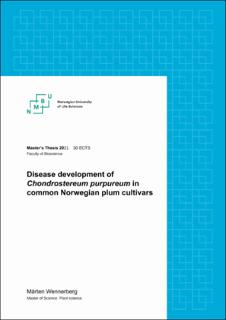| dc.description.abstract | Silver leaf disease, caused by the basidiomycete Chondrostereum purpureum, is a growing problem in Norwegian plum production. It affects the overall health and lifespan of the fruit trees. The inoculation experiments in this study set out to attain more knowledge regarding disease development of the fungus under Norwegian conditions. They were performed at NIBIO Ullensvang and Ås between fall 2019 and fall 2020. Different inoculation methods were used on the main plum cultivars used in Norwegian production (Edda, Jubileum, Mallard, Opal, and Reeves) utilizing five C. purpureum isolates of different origin. The results of the inoculations, using map-pins with mycelium placed in newly developed side shoots and 1-year old side shoots in an established field, were unreliable and the method was found ill suited for field inoculations. The map-pin method did work well in more controlled conditions with whips in pots. Map-pin inoculation of whips developed leaf symptoms after 45 days outdoors and 35 days in growth chamber experiments. Fruiting bodies developed in August on one root stump that was left in the field. In addition, two trees in the outdoor experiment had silver leaf infections that had come prior to inoculations. Young graftings, inoculated via agar pieces with mycelium, showed leaf symptoms 77 days after inoculation no matter if the inoculation point being in the rootstock or scion. Almost all graftings displayed leaf symptoms at this time. The fact that the graftings were very small appeared to be the reason behind the many severe infections in this experiment. Five dead graftings, inoculated in the rootstock, developed fruiting bodies in the field in August before final assessments and were identified as C. purpureum. This is a good example of how infected trees can become inoculum sources in the field if not removed. Inoculations with mycelium, performed in fall and winter, developed leaf symptoms already at leaf emergence in May and did not seem to be inhibited by the colder conditions during inoculation and wintertime. Overall, the methods using agar pieces with mycelium caused the most infections and were the most severe in younger trees. For future studies susceptibility of the different cultivars should be investigated to provide a preference for Norwegian fruit farmers. Studies investigating disease development spanning over multiple seasons should be done on well-established fields to see long term effects of the fungus. Such an experiment could also provide better insight to which cultivars are more resilient than others and would be of helpful for future farm practices in Norway. | en_US |

